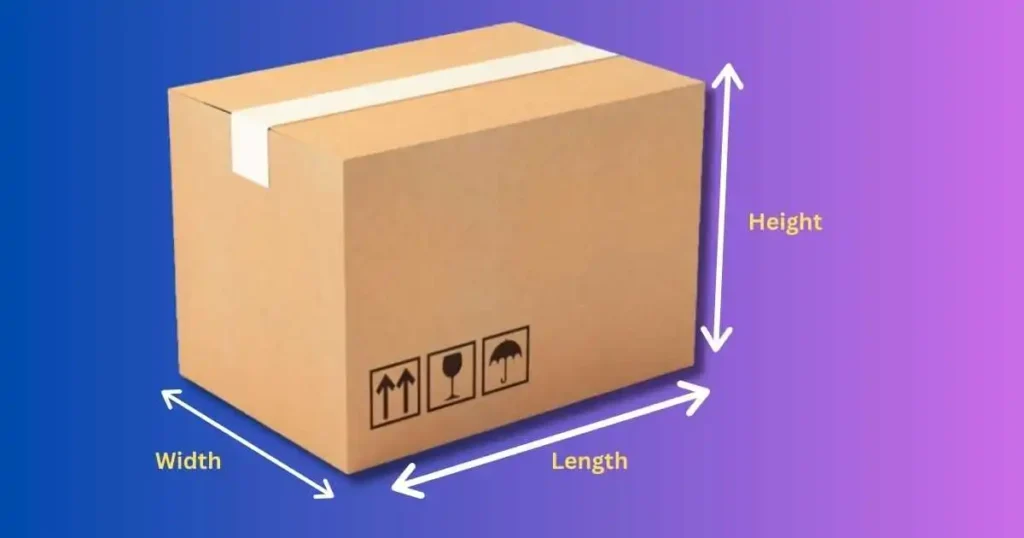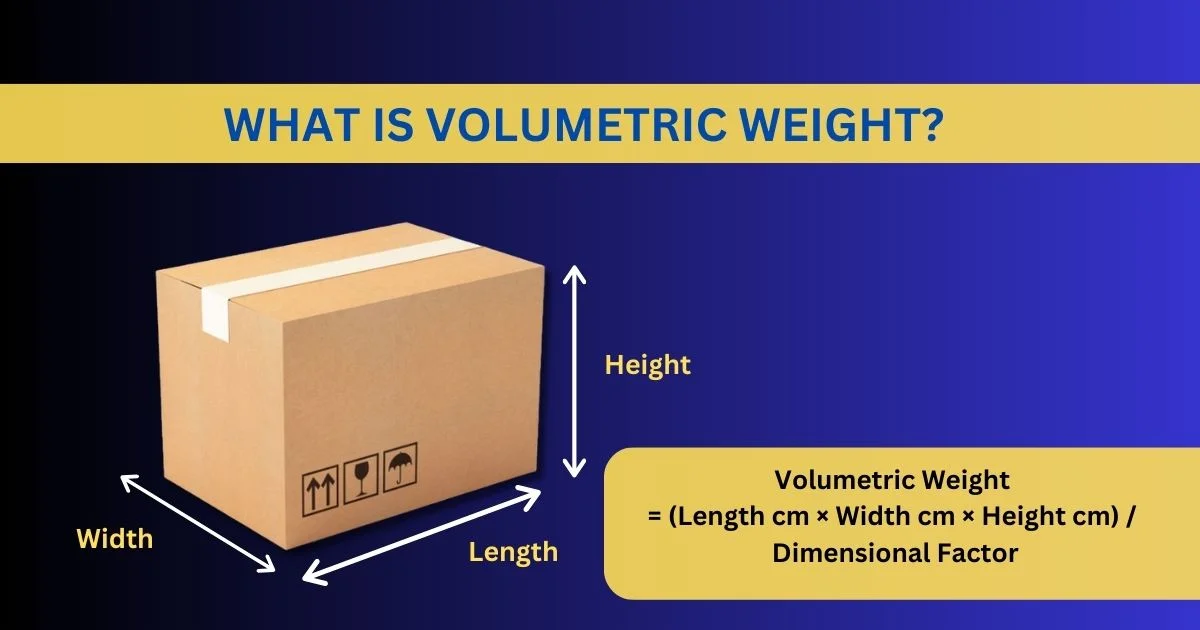Have you ever sent a package through Speed Post or any other courier company?
You must have observed that the courier personnel measuring the length, breadth, height, and weight of your parcel in order to calculate the courier charges.
In reality, the courier staff measures the volumetric weight of the package.
Now, the question arises is What is Volumentric Weight? How to Calculate Volumetric Weight?
What is the tool required for Volumetric Weight Calculation?
Volumetric weight, also known as dimensional weight, is a method used to calculate the weight of a package based on its size (length, breadth, and height) rather than its actual weight.
In this article, we will discuss the concept of Volumetric Weight, how to calculate volumetric weight along with the formula called volumetric weight calculator.
Next, we will explore the significance of Volumetric Weight and volumetric weight calculation for logistics companies when shipping products.
Definition of Volumetric Weight
It is essential for you to know what volumetric weight is and its definition before we proceed for how to calculate volumetric weight.
Volumetric weight, also known as dimensional weight or DIM weight, is a pricing technique used by shipping companies to calculate the cost of shipping a package.
Following is considered while volumetric weight calculation:
- Length of the package
- Width of the package
- Height of the package
- Actual weight of the package

How to Calculate Volumetric Weight?
Volumetric weight It is calculated by multiplying the length, width, and height of the package in centimeters and dividing by a dimensional factor.
The dimensional factor is different for each shipping company, but it is typically between 4,000 and 6,000.
The volumetric weight calculation formula for a package (in centimeters) is as follows:
Volumetric Weight = (Length cm × Width cm × Height cm) / Dimensional Factor
In this formula:
- Length cm refers to the length of the package in centimeters
- Width cm refers to the width of the package in centimeters
- Height cm refers to the height of the package in centimeters
- Dimensional Factor is a constant value set by the shipping carrier, which is used to convert the package’s volume into a weight equivalent
How to calculate volumetric weight for courier?
Let us understand how to calculate volumetric weight for a courier with an example.
Let us take a package that is 20 centimeters long, 10 centimeters wide, and 10 centimeters high would have a volumetric weight of 400 cubic centimeters.
Package dimensions: Length = 20 cm Width = 10 cm Height = 10 cm
Volumetric Weight = (Length cm × Width cm × Height cm) / Dimensional Factor
Let’s assume the dimensional factor is 5000 (this value can vary depending on the shipping carrier and their policy).
Volumetric Weight = (20 cm × 10 cm × 10 cm) / 5000
Volumetric Weight = (2000 cm³) / 5000
Volumetric Weight ≈ 0.4 kg
So, the volumetric weight of the package is approximately 0.4 kilograms.
If the dimensional factor for the shipping company is 5,000, then the volumetric weight of the package would be 0.8 kilograms.
Why is Volumetric Weight Important?
Volumetric weight is significant in shipping logistics for a few reasons:
- First, it helps shipping agencies use their space better. By charging based on how much space a package takes up, carriers can make sure they’re using their vehicles as efficiently as possible.
- Secondly, volumetric weight affects shipping costs. If you are not aware of how to calculate volumetric weight, you may end up paying money more than required for shipping. This is especially true for lightweight but bulky items.
- Lastly, knowledge of how to calculate volumetric weight empowers you to compare shipping rates across different carriers. Each shipping agency may have its own formula for calculating volumetric weight. Being familiar with it allows you to make fair comparisons and choose the most cost-effective option for your shipments.
The Significance of Volumetric Weight in Shipping Companies
Understanding how to calculate volumetric weight may not be enough if you are a frequent shipper of parcels and packages with varying dimensions, shapes, and sizes.
However, having an idea of the importance of volumetric weight will inevitably help you save a significant amount of money.
Let’s look into the significance of volumetric weight in shipping companies and how it impacts your budget in the upcoming paragraphs.
Cost Considerations
For shipping companies, managing costs is crucial for their profitability and competitiveness.
Volumetric weight enables them to optimize cargo space and transportation efficiency, ensuring that they charge appropriately for the resources utilized.
It also prevents customers from underpaying for large, lightweight packages, which would otherwise be more expensive to ship.
Maximizing Cargo Space
By considering volumetric weight, shipping companies can make the most of the available cargo space in their containers and vehicles.
Efficiently utilizing space allows them to transport more packages in a single trip, reducing fuel consumption and minimizing the overall environmental impact of shipping operations.
Transportation Regulations
Volumetric weight plays a role in determining the type of transportation and the shipping methods used for specific packages.
Some carriers have weight and size restrictions, and adhering to volumetric weight guidelines helps ensure smooth and efficient shipping operations.
Differences Between Actual Weight and Volumetric Weight
The differences between actual weight and volumetric weight is tabulated below:
| Aspect | Actual Weight | Volumetric Weight |
|---|---|---|
| Definition | Usually measured in pounds or kilograms | Calculated based on the package’s size or volume |
| Calculation Method | Measured using a scale | Package’s dimensions (length, width, height) and a volumetric factor |
| Applicability | Used for shipping cost based on actual package weight. | Used when shipping cost is based on higher of volumetric or actual weight. |
| Relevance | For dense and heavy items | For lightweight, bulky items, or packages with empty spaces |
| Unit of Measurement | Measured in pounds or kilograms | Measured in volumetric pounds or volumetric kilograms |
| Billing Consideration | Shipping cost is based on the actual weight | Shipping cost is based on the higher of the actual weight and the volumetric weight |
| Formula | None, as it is the direct weight measurement | Volumetric Weight (VW) = (Length x Width x Height) / Volumetric Factor |
| Purpose | When shipping heavy items | Ensures fair pricing for shipping large, lightweight items occupying significant space |
Factors Affecting Volumetric Weight
Below are the factors affecting volumetric weight of your shipment:
Packaging Materials
The choice of packaging materials can significantly impact the volumetric weight of a package.
Using lightweight, space-efficient materials can reduce volumetric weight without compromising the package’s safety and security.
Shipping Methods
Different shipping methods may have varying guidelines for calculating volumetric weight.
Air freight, for example, often has stricter rules due to limited cargo space, making volumetric weight a critical factor for cost estimation.
How to Reduce Volumetric Weight?
Reducing the volumetric weight can lower shipping charges.
It is important to know how to reduce the size and weight of a package, which ultimately affects shipping costs.
You can implement the following strategies to reduce volumetric weight before shipping:
Efficient Packaging Techniques
Implementing efficient packaging techniques can help reduce the overall volumetric weight of packages.
Using packaging that fits the items tightly and reduces empty space can save money for companies and shoppers.
Using Smaller Containers
When shipping small items, choosing appropriately sized containers can help reduce volumetric weight.
Avoiding excessive packaging materials can also contribute to a more eco-friendly shipping process.
Consolidate shipments
If you have multiple items to ship, try to consolidate them into a single package. This reduces the overall volumetric weight and can result in cost savings.
Explore Alternative Shipping Methods:
Some carriers offer shipping options specifically designed for lightweight but bulky items.
You can explore these alternatives to find the most cost-effective solution for your shipments.
Regularly Review Carrier Rates
Shipping rates and volumetric conversion factors can vary between carriers. Regularly review rates to ensure you’re getting the best deal for your shipments.
By implementing these tips, you can optimize your volumetric weight calculations and save on shipping costs.
Bottom Line
With this, I hope you have understood how to calculate volumetric weight.
By understanding this important aspect of shipping logistics, you can optimize your packaging, minimize costs, and make informed decisions when shipping your items.
Remember to measure your packages accurately, convert measurements to the same unit, and use the appropriate formula to calculate volumetric weight.
Consider the impact of volumetric weight on shipping costs and explore ways to optimize your packaging.
By following these steps and tips, you’ll be well-equipped to take control of your shipping logistics and save both time and money. Say goodbye to overpaying for shipping costs and hello to efficient and cost-effective shipping. Happy shipping!
Related Articles :
Speed Post Delivery Timings: Domestic & International
Speed Post Charges Calculator [100% Accurate] : All Countries
Is volumetric weight 5000 or 6000?
Neither 5000 nor 6000 is a volumetric weight.
Different shipping agencies may use factors like 5000 or 6000 in their volumetric weight calculation formulas, but the actual volumetric weight of a package would depend on its dimensions and the specific formula being applied by the shipping company.
Why should volumetric weight be divided by 5000?
Volumetric weight is used to determine shipping cost based on package size. It’s divided by factors like 5000 to calculate chargeable weight, which considers bulky items that occupy space. Charges depend on actual or volumetric weight, whichever is higher. Check with the carrier for specific rules and costs.
Why do we divide by 6000 for volumetric weight?
The practice of dividing by 6000 (or other factors) for volumetric weight is used by certain shipping carriers as a conversion method. This factor is applied when calculating the chargeable weight of a package based on its size and volume.
What is volumetric charged weight?
Volumetric charged weight is used in shipping to calculate the cost based on a package’s size and volume, not its actual weight. It’s determined using the package’s dimensions and a volumetric conversion factor.
How do I calculate volumetric weight?
The formula to calculate volumetric weight is:
Volumetric Weight (in kg) = (Length x Width x Height) / Volumetric Conversion Factor
How do you find volumetric weight?
The formula to find volumetric weight is:
Volumetric Weight (in kg) = (Length x Width x Height) / Volumetric Conversion Factor
What is volumetric weight of 1kg?
The volumetric weight of 1 kg depends on the dimensions of the package being shipped. Volumetric weight is calculated based on the package’s size and volume, not its actual weight.
